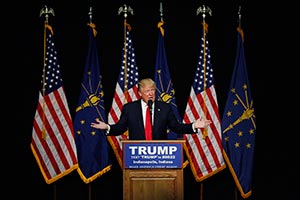Analysis: Trump Is Right — 'Border Adjustment' Tax Is Complicated

Donald Trump recently called the so-called border adjustment in the House Republican tax-reform plan “too complicated.” He’s got that right: The proposal to incorporate border-tax adjustments into business taxes has created infighting among some usually tight industry associations.
Economists are busy running models to simulate it, but they can’t find enough detail in the blueprint to get an accurate forecast. Trade lawyers are contemplating a host of lucrative cases at the World Trade Organization that would arise because the plan is outside of international rules. And Congress is swooning over the hundreds of billions of dollars in revenue it will yield.
“Anytime I hear border adjustment, I don’t love it,” Trump told the Wall Street Journal, “because usually it means we’re going to get adjusted into a bad deal. That’s what happens.”
What’s all the fuss?
By incorporating border-tax adjustments into business taxes, the House plan would make exports tax-exempt, while companies could not deduct expenditures on imports from their tax base. If it sounds like a tariff plus export subsidy, that is because it is. But it’s being peddled on the grounds that nearly all other countries do a similar border adjustment on their value-added taxes.
It’s true that other countries exempt exports from VAT while charging imports. However, this is a sensible thing to do for a sales tax. In contrast, economic analysis does not support border adjustment for a business tax.
Why is border adjustment OK for a VAT?
Border adjustment on VAT, like a sales tax, is not protectionist. Consider the situation in the United States, where most states effectively have border adjustments, just like foreign VATs.
For example, Maryland has a 6% sales tax that’s charged on imports to the state but not on exports. If you shop in Maryland, you pay the 6% tax, irrespective of where the goods were produced. So an Orioles sweatshirt sold in Maryland will have a 6% sales tax whether it’s produced in China, Delaware or Maryland.
But if the sweatshirt is sold in Delaware (a tax-free state), the Maryland sales tax doesn’t apply, even if it was produced in Maryland. From Maryland’s perspective, exports are untaxed and imports are taxed, but that doesn’t protect the state’s producers from competition because they face the same tax as all other sellers. Protection would require that the tax not apply to Maryland producers.
What’s the difference between the proposed tax and a VAT?
The cash-flow tax proposed in the House is discriminatory. The tax on domestically produced goods would be less than the tax on imports, and it would vary across sectors. Unlike the sales tax, the cash-flow tax with border adjustment would favor domestically produced goods.
In particular, it would have the odd feature that home goods would be taxed on total value added, less the wage bill; in contrast, foreign goods will be taxed on total value added. In the example above, the Maryland-produced sweatshirt will face a lower tax rate than the Chinese-produced sweatshirt, exactly as if a tariff were applied.
Effective import taxes are where it becomes even more complicated and has some industries panicked. Since the wage bill varies across sectors, there will be a web of different tax rates for domestically produced goods, while imports will be charged a uniform 20%. For supply chains, the variation in the tax will cascade through the production chain, with all imported inputs being taxed at a higher rate.
What’s the upside of border adjustment?
The plan is not without merit. The attraction of border tax adjustment is that it would eliminate much of the gaming of the tax system by U.S. corporations.
For example, the existing tax code offers incentives for Apple Inc. to shift profits to Ireland and overcharge for purchases from subsidiaries abroad. Border adjustment would remove those incentives.
Because imports are no longer deductible, their cost is irrelevant to the tax base. Similarly, in terms of exports, there would be no incentive to undercharge for them or to move production to a low-tax nation to reduce U.S. profits, since exports are excluded from taxable income.
An even bigger attraction to Congress is that the plan would raise billions of dollars, allowing for bigger corporate tax cuts. The U.S. annual trade deficit is running at $500 billion. All else equal, a 20% border adjustment would yield $100 billion of revenue a year or $1 trillion in 10 years.
Can the Republican plan be fixed?
The most efficient way to modify the House blueprint and make it consistent with international rules would be to levy the 20% tax as a VAT or near-VAT, by removing the wage deduction. At the same time, eliminate the existing 15% payroll tax, and use the additional revenue for the existing payroll commitments and other social spending.
A problem with shifting from a corporate tax to a VAT or near-VAT is that poor people are taxed at higher rates because they spend a greater share of their income on consumption. Provided the new tax is combined with a strong social safety net, it can be an efficient and equitable means of raising revenue.
In addition to not acting as trade protection in some sectors and damaging supply chains, these fixes would bring the tax in line with international norms.


